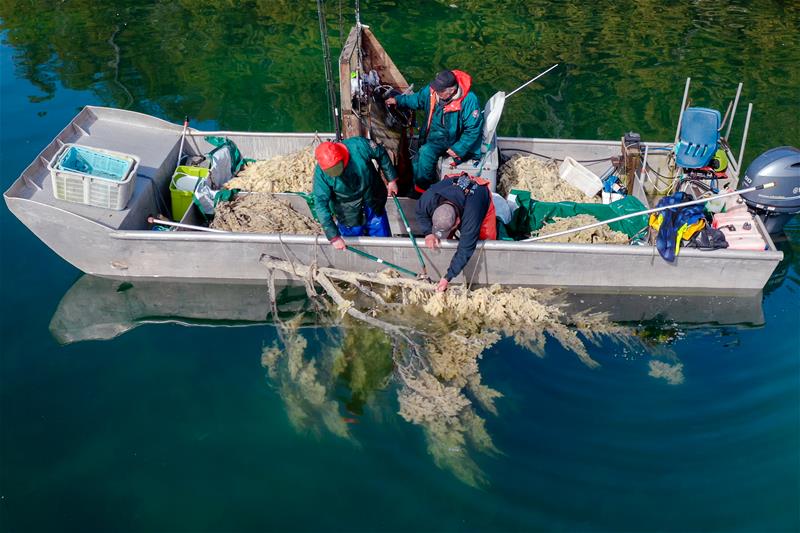Since our initial investigation of ocean opportunities in 2004, the Marine Conservation Initiative has aimed to support healthy and resilient ocean ecosystems that will sustain current and future generations. British Columbia has long been an important geography due to its bounty of resources from the land and the sea.
The Great Bear Sea region of British Columbia encompasses the coastal and marine ecosystems along the central and northern coasts of the province. The region is unique due to its intricate networks of fjords, islands, and inlets which teem with diverse wildlife and create conditions for glass sponge reefs, kelp forests, and seagrasses to foster robust populations of animals. It is also home to the Great Bear Rainforest, one of the largest intact temperate coastal rainforests in the world. Together, the Great Bear Sea and Rainforest complete a globally significant and integrated ecosystem.
The Indigenous First Nations in British Columbia continue to be responsible for the stewardship of this ecosystem, and they work with focus to ensure its health. As evidenced by their leadership, strong governance and engaged communities are an integral part of preserving ecosystems and achieving transformational change.

Kitasoo Xai’xais have been stewards of the Kiatsu Bay for thousands of years. Image courtesy of Kitasoo Xai’xais/Moonfish Media.
Protecting ecosystems in places like the Great Bear Sea is necessary, in part, due to the rise of commercial-scale industries, including fishing and logging, which risk depleting the environment upon which we all rely. Indigenous communities in the region specifically continue to depend on these adjacent areas as cultural and food sources. The communities are integral to the stewardship of the ecosystems so central to the Nations’ ways of life. The First Nations in the region provide hands-on stewardship actions, expertise, and knowledge on how to sustainably use natural resources for survival and protect them for current and future generations.
How to achieve this conservation vision and be responsible for sustainable natural resource management has been a widely discussed topic. In 2023, at the International Marine Protected Area Congress, IMPAC5, in Canada, thousands of practitioners from around the world came together to learn and share best practices, innovative solutions, and anticipated challenges in ocean stewardship. At the congress, 15 First Nations along with the Government of Canada and the Government of British Columbia announced their endorsement of the Marine Protected Area Network Action Plan for the Northern Shelf Bioregion. This plan represents a ground-breaking model of collaboration between multiple levels of governments including Indigenous communities, and ultimately serves as the blueprint for implementing the world’s largest Indigenous co-designed and co-governed marine protected area network.
Christine Smith-Martin, CEO of Coastal First Nations underscores the responsibility of Indigenous communities to steward the lands and waters they rely on. “The development of marine plans must be collaborative, because all communities take a different approach, and we need to find the balance between local communities and outside stakeholders,” she says. “We have to leave something for the next generations to come, like our grandparents left or us, which is why we’re always thinking about how to protect and steward the territories where we live.”
Effective long-term finance is essential to sustain stewardship and management of the ecosystem while also delivering positive economic and social outcomes. The Great Bear Sea Project Finance for Permanence, which closed in June 2024, brings together accountabilities for the bigger vision to steward the region. The closing of this significant agreement also builds on the landmark work that was previously accomplished in the Great Bear Rainforest. In 2016, as part of the ongoing work, a pivotal deal doubled the amount of temperate, old-growth forest designated off-limits to logging. The Great Bear Rainforest agreements of the early 2000s enabled this milestone, by establishing long-term finance to both steward the region and develop a conservation economy that benefits people and the ecosystem.
Dallas Smith, president of Na̲nwak̲olas Council, sees the benefit of the Project Finance of Permanence in the Great Bear Sea, as well as the needed balance in the region.
“The closure of the Project Finance for Permanence is so important because our First Nations were able to stand up together, find our energy and drive towards our goal,” Smith says. “The hope moving forward is that we can spread our knowledge and network. The effects of climate change on British Columbia and other regions will require increased Indigenous leadership if we’re to preserve our ecosystems and communities.”
The closure of the Great Bear Sea Project Finance for Permanence is a crucial step toward conserving the globally significant land and seascapes of British Columbia. Over the coming decades, the First Nations will build from this milestone and use it to steward these remarkable ecosystems and the well-being of their communities for current and future generations.

Message sent
Thank you for sharing.